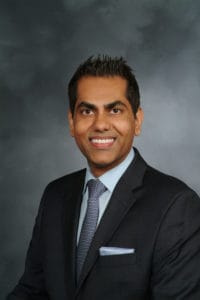A man walking in off the street to a drug store in Manhattan got key advice from a digital doctor visit that in all likelihood saved his life. In this case, it was by seeking treatment before having a fatal heart attack after a NewYork-Presbyterian/Weill Cornell Medical Center doctor during a telehealth session diagnosed the patient as having congestive heart failure.
On March 27, Ronald Wuaten, a 36-year-old information technology worker was at work at his company in the financial services district near Wall Street when he told co-workers he had shortness of breath after a few days of feeling ill at home and having some difficulty walking. Wuaten, who did not have a primary care physician or sought regular healthcare treatment, asked co-workers where to find the nearest walk-in clinic.

Dr. Rahul Sharma
One co-worker told Wuaten of a telehealth kiosk in a Duane Reade pharmacy about a block away from his office. Duane Read, a part of Walgreens Co., operates a telehealth kiosk in conjunction with NewYork-Presbyterian/Weill Cornell Medical Center at 40 Wall St. The kiosk, located in a private room inside the store, offers instant examination, diagnosis and treatment of usually non-life-threatening illnesses and injuries. A patient can use the kiosk to go online and connect with an emergency medical physician, who provides exams through a high-definition video-conference connection.
In this case, Wuaten conducted a telehealth visit with Dr. Rahul Sharma, NewYork-Presbyterian/Weill Cornell Medical Center emergency physician-in-chief. After about a 15-minute visit where Sharma checked Wuaten’s oxygen level, performed a video physical exam by asking the patient to stand up, move around and put his arms over his head and obtaining a detailed health history, Sharma determined that Wuaten was in congestive heart failure. “He was complaining of fluid in the lungs, having shortness of breath and in pain,” Sharma says.
After making the diagnosis, Sharma told Wuaten he needed medical care in the medical center emergency room about a block away and notified emergency room staff that Wuaten was on his way in. Because of the shortness of the walk to the medical center, it was not necessary to call an ambulance, call 911 or treat Wuaten in the store.
When he arrived at the emergency room, he was diagnosed and is now receiving treatment for congestive heart failure. Wuaten is still feeling well, the medical center says. The use of telehealth—in this case helping to detect a life-threatening disease and get the patient to get immediate treatment— demonstrates the role telehealth plays where patients have no access to medical care. “Telehealth is a way to practice medicine,” Sharma says. “In this case, it helped a patient who told us he had not seen a doctor in years.”
Keep up with latest coverage on digital healthcare by signing up for Internet Health Management News today.